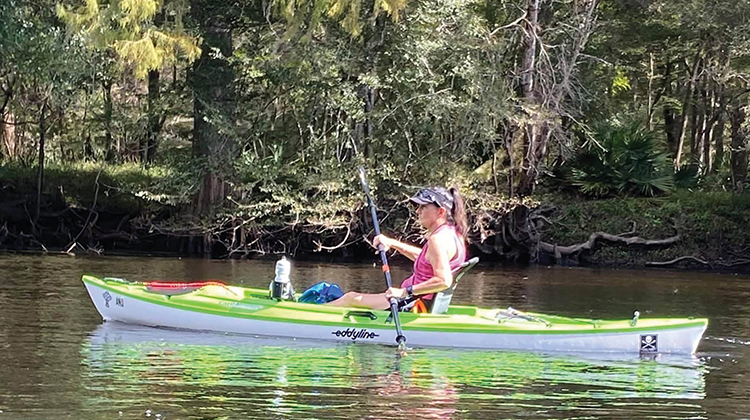By Rebecca Maglischo
Photos Courtesy of the Florida Spring
As the temperature rises, Floridians turn to the water for a bit of a reprieve. While a day at the beach might be the first idea that enters the mind, Florida is blessed with an abundance of waterways from sparkling lakes and spring runs to blackwater rivers and more. These beautiful waterways are quilted into the landscape, creating opportunity for an abundance of other outdoor water adventures. Canoers and kayakers can choose from easy floats with the family to multi-day expeditions requiring advanced skills and specialized boats and gear. Rather than simply languish beside the water, paddlers have a unique opportunity to explore Florida from the other side of the shoreline; to engage with the water! A quiet observant paddler can enjoy excellent wildlife viewing, explore interesting fishing nooks, or simply log miles of exercise in a breathtaking setting.

The waterways of Florida are as sprawling as they are connected. These pathways carry the history and stories of long-ago extinct creatures and ancient tribes. The porous limestone that underlies the Florida peninsula, sometimes thousands of feet thick, is the Floridan aquifer. The Florida landmass emerged from the sea tens of thousands of years ago and the lime rock “trapped” the sea water. Over the centuries, the rains and freshwater began to form tunnels and cavities. These underground distributions of water collected into what would become a giant reservoir. In some areas, where the crust is thin, this water bubbles to the surface, resulting in more than 600 freshwater springs. Some are small – barely noticeable, really – while others are large enough to pump out millions of gallons of water a day, enough to feed a major river. Ancient Floridians would have relied on these for fresh water, as well as transportation and food.

The Florida waterways were the original highways and even as recently as the early 1900s, the southern interior was a vast and foreboding swampland, largely inaccessible except with a paddle. Early humans gathered by the springs where they fed on mastodon, mammoth, ground sloth, giant armadillo and beaver. They transported goods to new sites in dugout cypress canoes. The footpaths along the rivers connected villages and even formed the original network on which many modern-day roads were built. Today, divers sometimes find bones and teeth, as well as stone-age tools, from this forgotten age.
Efforts to tame the watery landscape took many twists and turns, guided by the needs and capabilities of the day. As Florida and the other southern states began to grow, there were very few railroads to transport passengers and freight from local enterprises to salt water ports where they could be shipped to northern markets. This made Florida rivers a logical and important way to connect the state to the rest of the world.

Today, the waters of Florida that once served as highways are more like lazy country roads. Here you can escape the hustle and bustle, find tranquility, and enjoy encounters with the wildlife. Florida is a paddler’s paradise with the largest concentration of springs in the world. The inlets, bays, mangrove forests and coastline offer even more options! The first Florida paddling trails were designated in the early 1970s, and trails have been added to the list ever since. Total mileage for the state-designated trails is now more than 4,000 miles! The Florida Office of Greenways and Trails (OGT) coordinates the designated trails and works with or seeks to identify local and regional managers. The Florida Circumnavigational Saltwater Paddling Trail (commonly referred to as the CT) is a 1,515-mile sea kayaking paradise that includes every Florida coastal habitat type. Numerous historical sites and points of interest are accessible by kayak along with colorful fishing communities and urban centers.

The Florida Department of Environmental Protection manages an informative website with maps, tips and links for more information: “Local outfitters, paddling clubs and the non-profit Florida Paddling Trails Association are good sources for learning about the numerous non-designated paddling trails.” The website also suggests that “taking a guided trip with a group such as Paddle Florida is a great way to break into multi-day adventures on the water.” The Florida Fish and Wildlife Conservation Commission provides further information encouraging paddlers to take part in conservation. By becoming a Citizen Scientist, you can “help expand our knowledge of Florida’s fish and wildlife and assist the FWC with research and management efforts.”

If hitting the water sounds like the perfect adventure, these are a few well-known spots in Central Florida: Chassahowitzka Springs, Homosassa Springs, Kings Bay Springs, Rainbow Springs, or Weeki Wachee Springs. An outfitter can provide basic equipment like the kayak or canoe, paddles and life jacket. But you’ll still want to do a little preparation yourself. Be sure to wear sunscreen, and a hat is great additional sun protection. Purchase a dry bag to transport your phone, keys, ID, and food. Pack plenty of water, a first aid kit and a whistle, and be sure to have a buddy. Take all the photos you want, but don’t interact with the wildlife. And finally, leave the waterways pristine by removing all food scraps and trash.
A day on the water in Florida is certain to be memorable. Nowhere else on Earth supports such diversity of habitat that is so accessible for personal adventure. The history of this landscape began with water and the lives of Floridians have ebbed and flowed through this aquatic connection. To traverse the waterways is to simultaneously link oneself to the past and propel oneself forward. It is the story of water. It is the story of humans.





